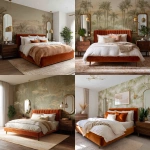Explore the Best AI Image Gallery

Beyond Pixels: How Wearable Tech is Redefining the Creative Canvas
The creative landscape is undergoing a profound transformation, fueled by the emergence of innovative wearable technologies. These devices, once confined to fitness tracking and communication, are now empowering artists, designers, and innovators to express themselves in unprecedented ways, blurring the lines between the physical and digital realms.
A Symphony of Senses: Wearable Tech Applications in Creative Fields
Wearable technology is opening doors to a plethora of creative applications across various disciplines:
- Interactive Art Installations: Imagine walking through an art exhibit where your movements trigger dynamic light patterns or soundscapes, creating an immersive and personalized experience. Wearables can act as sensors, responding to the viewers presence and transforming static artwork into interactive installations.
- Fashion Design Revolution: Clothing is evolving beyond mere aesthetics. Smart textiles integrated with wearables can adapt to the wearers environment, changing color or texture based on temperature or light conditions. This opens up a world of dynamic fashion experiences, blurring the lines between garment and technology.
- Music Composition and Performance: Musicians are embracing wearables to create innovative soundscapes and performance styles. Wearable sensors can capture subtle movements, translating them into musical notes or triggering sound effects. This allows for a more expressive and interactive musical experience.
- Virtual Reality (VR) and Augmented Reality (AR) Enhancements: Wearable devices like VR headsets are revolutionizing creative workflows. Artists can now sculpt in 3D space, designers can visualize product concepts in immersive environments, and filmmakers can create groundbreaking visual effects.
Navigating the Ethical Terrain
As with any powerful technology, wearable tech raises ethical considerations that need careful consideration:
- Data Privacy and Security: Wearables collect vast amounts of personal data. It is crucial to ensure robust security measures are in place to protect user privacy and prevent unauthorized access to sensitive information.
- Algorithmic Bias: AI algorithms used in wearable technology can perpetuate existing societal biases if not carefully designed and monitored. It is essential to promote fairness and inclusivity in the development and deployment of these systems.
- Accessibility and Equity: Access to wearable technology should be equitable, ensuring that individuals from all backgrounds and socioeconomic levels can benefit from its creative potential.
Future Horizons: A Convergence of Creativity and Technology
The future of wearable technology in the creative industry is brimming with possibilities:
- Brain-Computer Interfaces (BCIs): Imagine controlling digital creations with your thoughts. BCIs hold immense potential for artists to express themselves in entirely new ways, bypassing traditional physical limitations.
- Personalized Creative Experiences: Wearables will enable highly personalized creative journeys. AI algorithms can learn individual preferences and tailor creative tools and content to each users unique style and needs.
- Collaborative Creativity on a Global Scale: Wearable tech will facilitate seamless collaboration between artists and designers worldwide, breaking down geographical barriers and fostering innovative partnerships.
As wearable technology continues to evolve, its impact on the creative industry will only intensify. By embracing this transformative potential while addressing ethical considerations, we can unlock a future where creativity knows no bounds.
](https://images.ai-img.art/thumbnails/150/469bffae134ea97666025052588e76bb4dd4b6b98c4888cfd7873929a73156ff.webp)




](https://images.ai-img.art/thumbnails/150/985b7bf314caa205e59a2c973e979ce77cf5b24ca39799fffe2e30ea7c79ef07.webp)



](https://images.ai-img.art/thumbnails/150/b94716d4b88da3e1ec3ab12162616a52ff5698251ac791ddf8478649889a0f47.webp)
](https://images.ai-img.art/thumbnails/150/4c67c727683a835917441757b71ace563950f9178fa4826e09a55cfb092ac715.webp)



](https://images.ai-img.art/thumbnails/150/4c5bdb0a0a1f761a911521333b9e3463c885aa247b42d1d311a97f2aa2c513d2.webp)
](https://images.ai-img.art/thumbnails/150/fe996254fcb758c1365f3a22783ee6112ed5e34579deb401de674b06938efb2a.webp)
























